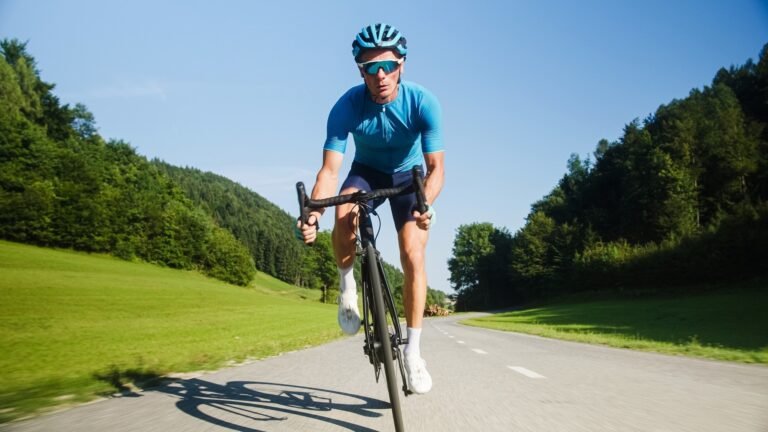New research highlights the powerful impact of endurance cycling on fat distribution and cardiometabolic health, emphasizing fitness over calorie restriction for long-term health benefits.
Study: Effects of 1,144 km of road cycling performed over 7 days: a cardiometabolic imaging study. Image credit: 24K-Production/Shutterstock.com
In a recent cohort study published in American Journal of Physiology-Endocrinology and Metabolism, Researchers investigated the effect of vigorous cycling on the cardiometabolic profiles, visceral fat and ectopic fat of middle-aged, male recreational cyclists.
They found that despite the increased energy intake, the cyclists experienced a significant reduction in visceral fat and fat mass, while maintaining high cardiorespiratory fitness.
Background
Regular exercise is known to reduce body fat, even without weight loss, if lean body mass is increased. In a notable 2015 study, middle-aged male cyclists cycled 2,700 km over 14 days, attempting to match their high energy expenditure with increased energy intake to maintain their weight.
While they managed to maintain a stable weight, this was misleading in terms of body composition. Participants lost 2.2 kg of body fat while gaining 2.5 kg of fat-free mass. This significant change in body composition occurred without imaging to confirm effects on visceral fat and ectopic fat.
The difference in how different types of fat respond to high volumes of exercise with minimal weight loss remains unexplored. Therefore, the researchers in the present study investigated the effects of one week of extreme road cycling on body fat distribution using magnetic resonance imaging (MRI).
About the study
The Extreme Exercise and Energy Expenditure (4E) study included 13 healthy male recreational cyclists from Quebec City, aged 50 to 66 years, who were accustomed to long-distance cycling (average 5,490 km/year) and had high cardiorespiratory fitness.
Participants were screened based on their ability to maintain an average pace of approximately 30 km/h and were excluded if they were previously competitive athletes, had cardiovascular problems, were taking certain medications, or had abnormal test results. A total of 11 cyclists completed the study.
Over the course of a week, participants cycled 1,144km in a 104km loop, with safety measures including police awareness and escort vehicles. Body composition, fat distribution, and cardiometabolic indices were assessed before and after the cycle period using magnetic resonance imaging and bioimpedance analysis.
Daily measurements were taken to monitor hydration and body weight, while energy intake was monitored through provided meals and individual food diaries. The cyclists’ data were compared with that of a reference group of 86 asymptomatic healthy men aged 50-66 who participated in a separate cardiometabolic risk study.
Statistical analysis included the use of post hoc analysis, age-adjusted linear mixed models, Tukey–Kramer post hoc tests, Pearson partial correlation coefficients, linear regression analyses, repeated-measures linear mixed models, Student’s t-test, and the Shapiro-Wilk test.
Results and discussion
No significant correlation was found between participants’ V̇o2 peak and annual cycling volume. Three participants did not complete the full distance due to exhaustion or mechanical problems, but all reported expected side effects, including muscle fatigue and discomfort.
Despite minimal mean weight loss of 1% and changes in body composition, the cyclists showed significant reductions in visceral fat (14.6%) and waist circumference. They maintained greater energy expenditure than intake on longer cycling days (208 km) compared to shorter (104 km), with a total energy deficit of 6,867 kcal over the week.
Their daily energy intake was higher on longer cycling days, with a macronutrient distribution indicating predominant carbohydrate intake.
Significant improvements in lipid profiles were observed, including a 21.5% reduction in total cholesterol and a 34.6% reduction in non-high-density lipoprotein cholesterol. Cyclists also showed a significant increase in the adiponectin/leptin ratio, indicating improved secretory function of adipose tissue. However, no significant changes were found in subcutaneous and cardiac adiposity or liver fat content.
The present study documented, for the first time, the diverse changes in subcutaneous, visceral, and ectopic adiposity after participants participated in an extreme exercise protocol in which their energy intake was increased to minimize weight loss.
The study is supported by the use of gold standard measurements of body fat distribution and assessment of cardiorespiratory fitness, with detailed documentation of energy intake.
However, energy expenditure was not measured using the doubly labeled water method and the sample was limited to healthy, physically active Caucasian males. The findings need to be confirmed in further studies involving different populations, including women.
Conclusion
In conclusion, the seven-day road cycling experiment with middle-aged recreational cyclists resulted in a significant reduction in visceral obesity with minimal weight loss and low liver fat levels.
The findings highlight the need to assess changes in body composition beyond weight loss in endurance exercise interventions and emphasize the promotion of physical activity over caloric restriction to prevent obesity, especially in today’s environment of readily available, energy-dense processed foods.
While the present exercise protocol may not be feasible for widespread application, it reinforces the idea that humans may be designed for physical activity rather than minimal food intake.
